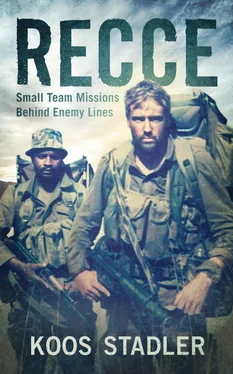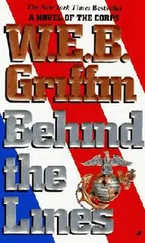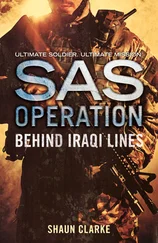Absolute secrecy was required about the base, for two reasons. Firstly, the conduct of pseudo-guerrilla operations meant that operatives were literally smuggled in and out of base, usually under cover of darkness and hidden in the back of a vehicle or helicopter, sometimes in South African military uniform or in civilian dress. Secondly, the base contained detention facilities with custom-made interrogation rooms where the captured SWAPO cadres were interrogated and eventually turned.
During my years in Special Forces, I worked with some outstanding intelligence officers, and Captain Dave Drew at 51 Commando was one of them. With his huge frame and overpowering personality, his knowledge of enemy structures and modus operandi, as well as his sixth sense for the enemy’s intentions, Dave was the face of intelligence at Ondangwa. He was also responsible for turning the newly captured SWAPO insurgents and preparing them for their new role as pseudo-guerrillas.
I once saw Dave in action during an interrogation session and was dumbfounded by his shrewd combination of cunning, veiled threat and technique to draw information from his subject. By the time the captured cadres arrived at Fort Rev, there was no need for the old nail-pulling, thumb-twisting routine, since the idea was to win their confidence and to convince them that we were not as bad as they had been led to believe. Many of them arrived wounded and had to be treated, which the medics did with great care, as it was one sure way of instilling confidence in their captors.
Dave played carefully on the captives’ fears of their communist-inspired bosses, as we knew that, once it became known that they had been captured by the “Boere”, they would never be trusted or taken back into the SWAPO structures. Few of them opted not to work with us, especially when the incentive of a healthy salary and all sorts of extravagant benefits (for them!) were thrown in.
Once an insurgent agreed to deploy and to lead us back to his ex-comrades, preferably within two or three weeks of his capture, Dave would know that he had switched. He would then convince the guy that he was doing the right thing and that he would be in extreme danger if his former comrades were to find out that he had been caught. In the big man’s favour was the fact that he knew the names of every single SWAPO commander, at every level, and in most cases where they hailed from and who their families were. He could therefore easily convince the captive insurgent that he had special means of communicating with Commander So-and-So.
Upon arrival at 51 Commando I was given a team of eight ex-SWAPO soldiers and deployed almost immediately. It was, to say the least, a massive culture shock for me. We were dropped off by a Casspir [11] Mine-protected infantry mobility vehicle originally developed by the CSIR.
in a sparsely populated area along the South West–Angolan border, and had to infiltrate to our area of operations in Ovamboland, acting as a new insurgent group that was moving into the area to establish itself.
The team acted as guerrillas and completely adopted the style and tactics of the SWAPO detachments. I was not prepared for this. There was no patrol formation, no communication signals, no semblance of tactical movement the way I had been taught. The team would stroll along in a single file, chatting away as they walked, weapons slung or just casually draped over the shoulder. When we passed a kraal, some would split off and pay the headman a visit. Sometimes they would spend hours in the kraal while the rest of us waited under the trees outside. Then they would come out with food for the patrol – goat meat or mahango , a type of maize porridge, which we would all eat with our hands from the same bowl.
Already on this first deployment I had to readjust my thinking – in fact, the very essence of my being as a soldier. For me it was quite literally a matter of adapt or die, since this kind of operation was completely alien to me and in sharp contrast with the disciplined and methodical way I had developed over the past years. My equipment, for instance, was still organised in typical Special Forces style. To switch to the rag-tag manner and appearance of the cadres required a major shift.
The objective of the operation was to collect information and to establish the group as a new SWAPO element in the area. While we made some useful contacts for future reference, I had no way of verifying the bits of information I was fed, since I could not understand the language and did not have a proper grasp of the political and tactical situation in the area.
The deployment went without incident and I was grateful for the “soft landing” when we returned to base after a week. Back at Fort Rev I had to make some modifications to my kit, as well as to my thinking.
During deployments we didn’t carry food – just one or two tins for an emergency. For food the team would rely entirely on the local population. While these guys were obviously used to this way of life, I never got accustomed to the erratic diet, and I became as thin as a rake. In an attempt to replenish my body’s dwindling resources, I bought huge amounts of Wilson’s toffees, which I would carry with me on deployments. In no time, they buggered up my teeth, as the toffee would stick to a tooth and cause it to pull out, root and all. I would end up in the middle of nowhere with a treasured tooth in the palm of my hand, and would have to carry it back to base for the dentist to fix.
My standard ops kit at this time was a small bag, resembling a rucksack, and the makeshift webbing worn by SWAPO cadres. On my head I generally sported an Afro wig, cut to size so as not to appear too conspicuous, and a large SWAPO hat that would cast a shadow over my Western features. A nicely groomed “Sam Nujoma” beard rounded off the picture. Instead of the good old “black is beautiful” camouflage cream, I used a brown cream similar to the stuff used by make-up artists. I applied it lavishly morning, noon and night, but the team would always keep me away from the local population or suspected SWAPO cadres. When we did encounter other people, they unobtrusively formed a shield and kept them occupied until I could disappear into the brush. Occasionally I came into direct contact with the local population, but we never detected any suspicion from their side.
However, I still slept with one eye open. I made a point of choosing a sleeping spot away from the rest of the group and always in a position where I would have some form of early warning, either in thick undergrowth or surrounded by a bed of dry leaves. Often I would change positions during the night. These were scary since I did not know the men and I had no idea who I could trust. We once deployed with a guy who had been on the other side scarcely one week before, and who, under Dave’s subtle guidance, had agreed to lead us to a specific point where two SWAPO detachment commanders would meet. He was not given a weapon, but, since there was no way of knowing if he could be trusted, I avoided him. I made sure that he didn’t know where I was bedding down, and I watched him closely as we approached the target area. The information turned out to be a lemon and I was quite relieved to return to base.
The lack of tactics and poor discipline – from my perspective, at least – inevitably led to a confrontation between me and some of the leading characters in the patrol. I became unable to tolerate the slack style and absence of discipline, as it appeared to be the norm even when we were back at base. The men would not listen to any advice or follow any form of tactics that I recommended. Basic drills, like moving from shadow to shadow when approaching a potential target area, were simply not observed, even after numerous rehearsal sessions. The excuse would always be, “but SWAPO wouldn’t do this”, or “SWAPO would do that”.
Читать дальше












